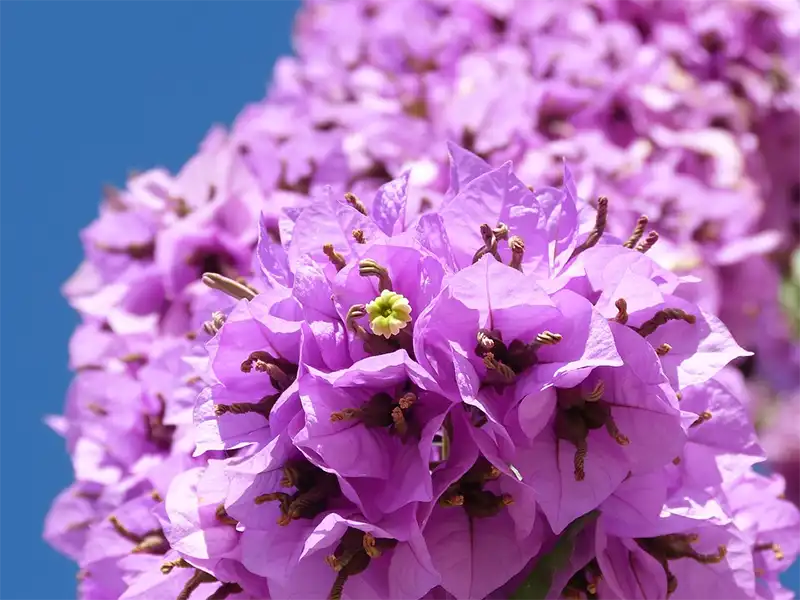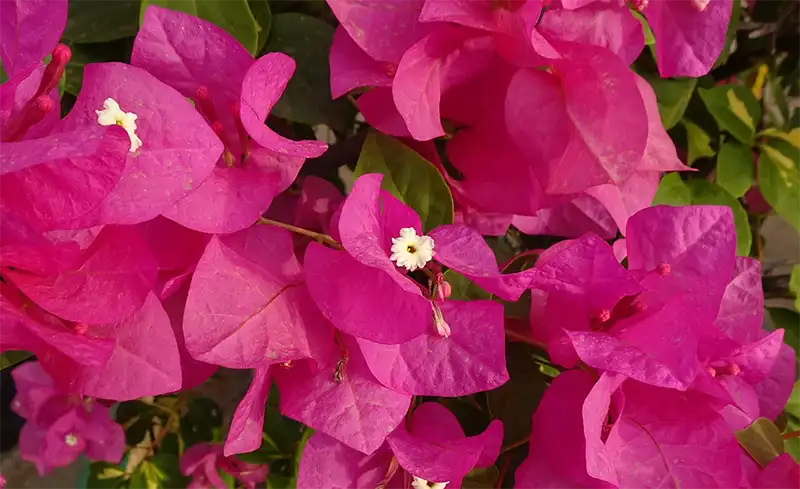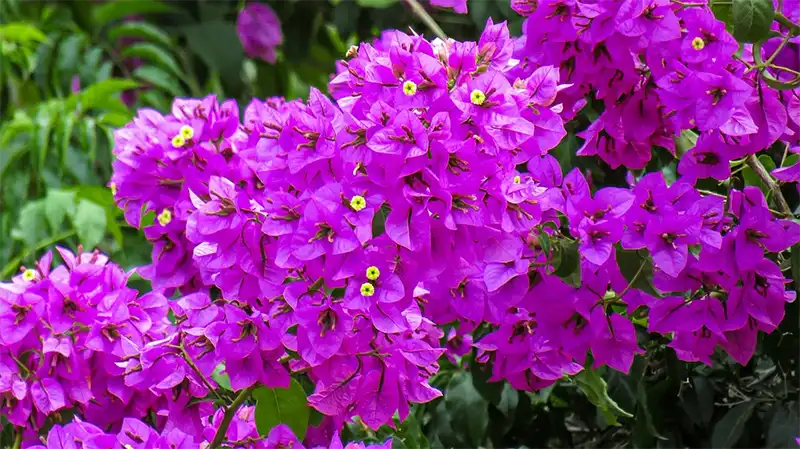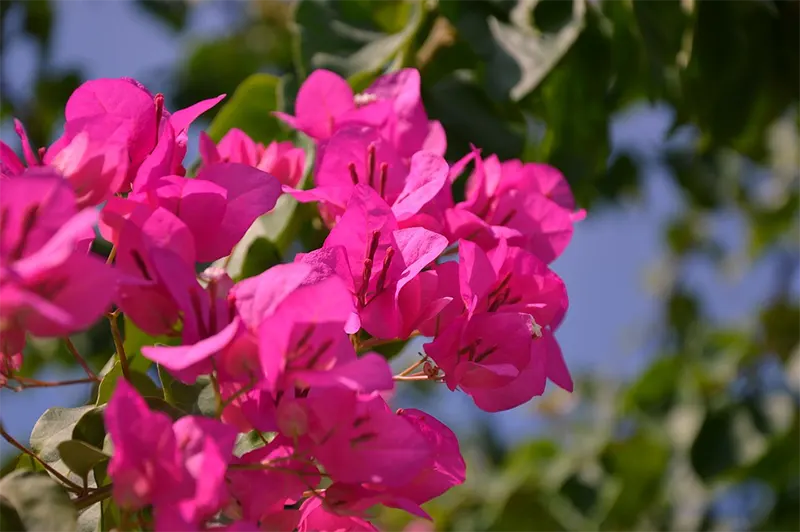Bougainvillea Spectabilis Bonsai Care Sheet
One of the top species you can grow as a bonsai is Bougainvillea spectabilis. Also known as the Greater Paperflower, it can grow up to 40 ft. in nature, which means you can develop a large bonsai tree with it. You’ll also love the various bract colors you can collect, as there are so many.
Let’s take a detailed look at how you can care for your Bougainvillea spectabilis bonsai.
Here are the topics we’ll cover:
Here are the topics we’ll cover:
01
02
03
04
05
06
07
Quick Bougainvillea Spectabilis Bonsai Care Sheet
Before we begin, we want to summarize the significant elements of this article. In this TL;DR, you’ll find the details you need to care for your Bougainvillea spectabilis bonsai.
Recommended soil
Loam or soil with high organic content and acidic levels
Watering
Dry conditions with a deep watering once a week
Potting season
Early spring
Shaping and pruning season
Spring and autumn
Light
Full sun
Fertilizing
Balanced NPK with higher nitrogen for leaf development
Propagation methods
Root and stem cuttings
Pests and diseases
Aphids, mealybug, red spider mite, cotton whitefly
Growth patterns
Vigorous evergreen traits all year round
Recommended styles
Formal and informal upright, cascading, semi-cascading, slanting, exposed root
Native Area
South America
Scientific Classification
- Clade: Eudicots
- Order: Caryophyllales
- Family: Nyctaginaceae
- Genus: Bougainvillea
- Species: Spectabilis

How to Care for a Bougainvillea Spectabilis Bonsai
It’s time to discuss the finer points of Bougainvillea spectabilis care. We break down every element for making sure it thrives in the right conditions. If you live in a zone that it struggles in, creating these conditions will help in making life better for it.
Best Soil
This species does well in sandy or loamy soil that has high levels of macronutrients with traces of micronutrients. The leaves enjoy high levels of nitrogen, while the flowers favor potassium. You’ll need acidic levels lower than 6.0 so that the bonsai can absorb the food and water without struggling.
Watering
Since the native Bougainvillea spectabilis is drought resistant, you’ll want to let the soil dry out before you water it. It’s best if you bathe it in water for about 30 mins to soak the substrate, and then leave it for about a week to dry out. This process encourages the bonsai to bloom more.
Repotting
The ideal time to repot the Bougainvillea spectabilis bonsai is early spring when the frost or cold starts to disappear. Don’t prune the roots too much, as the damage can be fatal to your bonsai tree. Take care to use the same type of soil you grew it in before.
Shaping and Pruning
There are two seasons you’ll do most of your pruning, namely, spring and autumn. For the former, you’ll maintain the design by cutting back as many of the new growths as possible.
It will encourage new branches to form, which will develop more flowers in summer. Since it’s evergreen, new shoots will appear in autumn, which is the best time for design pruning.
Location and Sunlight
Your Bougainvillea spectabilis bonsai tree will enjoy full sun in every season. If you plan to grow it indoors, we recommend placing it by a window where it can receive up to eight hours of light per day. However, it will do better in an outdoor environment while receiving some shade during the hottest part of the day.
Fertilizing
Your primary concern will be ensuring that the Greater Paperflower receives enough nutrients when the soil runs out of them. Most fertilizers have ratios of nitrogen, phosphorous, and potassium (NPK) indicated on them.
We recommend a balanced approach, but you can increase the nitrogen in spring for leave development. Also, you can create your own compost to increase acidity levels.
Propagation Methods
The two main ways you can propagate Bougainvillea spectabilis are via stem and root cuttings. Growing them from seed is also possible, but it’s more challenging to accomplish. Using 6-inch cuttings from softwood appears to be the easiest approach.
You should use a rooting hormone to assist with developing new roots. Water propagation is not recommended.
Pests and Diseases
Of all the potential pests that could harm your bonsai, the most dangerous are Aphids, mealybug, red spider mite, and the cotton whitefly. They’re known to feast on Bougainvillea spectabilis until it struggles to survive. The Looper caterpillar is another known threat, while you should watch out for fungal diseases like leaf spot and root rot.
Growth Patterns
As the species is evergreen, Bougainvillea spectabilis develops its leaves all year round, but mostly in spring and summer. You’ll see the flowers appear in summer, and you can develop more blooms if you create more ramifications. It grows vigorously in the warmer months.
Recommended Styles
Your bonsai needs loads of space for the foliage, so a forest or multiple trunking is not recommended. Formal and informal styles do well, while you can also aim for slanted. Many people use the broom methods, developing a dense mass of foliage at the top.
How to Identify Bougainvillea Spectabilis
You may be wondering if you have Bougainvillea spectabilis or one of the other species. Don’t worry; there is a way you can identify it via specific components of the tree. When all else fails, you can ask an expert or send us some photos, and we’ll try to assist you.
Size
This species is by far the largest in the genus, growing up to 40 ft. in the wild. Even as a bonsai, you can cultivate it into a huge size, while maintaining it as a small tree may be challenging. You’ll need to prune it often to reduce the leaf size on your bonsai.
Leaves and Thorns
There are many thorns among the branches, and the downy leaves are green. What sets the Bougainvillea spectabilis apart from the other species is that the leaves have smooth undersides, while the glabra has fine hairs, for example. They are shaped like small hearts rather than the lance appearance of others.
Flowers
The flowers are much the same as any other Bougainvillea. They are small and white, with little dashes of yellow. They usually attract moths, butterflies, and bees, which makes an excellent addition to your bonsai garden when they come around to visit.
Bracts
When it comes to the popular bracts that display the bonsai color, there are white, mauve, red, orange, and purple-red. You’ll seldom find yellow like on some of the other species. They usually surround the flowers in whorls of three.
Common Issues When Caring for a Bougainvillea Spectabilis Bonsai
When caring for your Bougainvillea spectabilis tree, there are a few problems you’ll come across. We may have mentioned some of them already, but it’s better if we consolidate the information into one place for you. Here are some of the troubles you can expect:
- Leaf spot: This fungal disease appears on the underside of leaves. It occurs when spores land on them and start the sporulation process. The best way to deal with it is to remove the infected leaves or spray fungicide.
- Root rot: Since this species loves drought conditions, watering too much can cause fungus to form on the roots. It will inhibit its ability to absorb nutrients. Let the soil dry out for a few days.
- Pests: We’ve already mentioned some of the most potent pests that might infect your bonsai. The best treatment is to spray organic pesticides once a week as required.
- Leaf curl or burn: While the Bougainvillea spectabilis loves full sun for several hours, you need to provide some shade during peak afternoon. The blistering sunlight may be burning the leaves.
Curling or wilting bracts: When you see the bracts wilting, you don’t have to worry about any problems. It usually happens when seeds are forming, so you may be able to propagate a few of them when the pods appear.
Interesting Facts About Bougainvillea Spectabilis Bonsai
One more thing we’d like to add is some interesting facts about the Bougainvillea spectabilis. It should peak your excitement about owning this amazing bonsai, while we’ll share any history we know about or found online. Let us know if there’s anything we missed.
- This species is an evergreen climber that looks like a vine in nature, but you can still grow it as a bonsai tree
- The bracts are modified leaves that attract pollinating insects to the small flowers
- Some people have been known to use extracts from Bougainvillea spectabilis for fertility issues and as an antioxidant, among other medical uses
- You can also grow it as a hedge along your fence, which will put on an outstanding floral display
- Its nickname ‘Greater Paperflower’ relates to its size, as it grows up to about 40 ft. In contrast, glabra is known as the Lesser Paperflower and only reaches 12 ft.
Final Thoughts
The Bougainvillea spectabilis bonsai is an outstanding species, giving you an opportunity to grow a large bonsai. When you cultivate the foliage properly, you can expect a massive amount of flowers to form. Look after your tree, and it will put on an excellent show for you in the summer.
FAQ About Bougainvillea Spectabilis Bonsai
With the meat of our article complete, we’ve compiled some questions we’ve seen readers ask about this species. We’ll do our best to answer as many of them here as we can. Please feel free to send us any other queries you may have that are not listed here.
One of the primary differences is that Bougainvillea spectabilis has smooth leaf undersides, while glabra has a few fine hairs. Also, it has angled floral tubes, while glabra has rounded ones. Spectabilis has shorter floral bracts despite how large the tree grows.
The common name of Bougainvillea spectabilis is Greater Bougainvillea or Paperflower. It references how huge the species grows compared to the other species in the genus. For instance, B. glabra is known as the Lesser Paperflower for this very reason.
There are many aspects to consider when caring for this bonsai. It needs to have dry soil now and again as it enjoys drought conditions, while you should soak it at least once a week. It wants full sunlight to help it develop the leaves and flowers, while you should aim and high acidity levels in the soil.
While the Bougainvillea species are mildly toxic, it will only be serious if you ingest large amounts. Many people have used extracts to make medicines and heal illnesses, so they can be taken orally when prepared properly. However, it’s best if you don’t make any strange mixtures at home without consulting an expert.
When looking at the aqueous extract of Bougainvillea spectabilis, some people in the past have used it for fertility control. While some tests still need to be done, it’s said that it has anticancer, antiulcer, antihepatotoxic, antihyperlipidemic, anti-inflammatory, antioxidant, and antimicrobial properties. For use, we simply enjoy the calming effect of the bracts on the bonsai.
For those that don’t know, inflorescence refers to a cluster of flowers or a branch system. When it comes to Bougainvillea spectabilis, it has terminal panicles or branched axillaries. There are usually three petaloid bracts around the flowers in an involucre arrangement.
Actually, this species has sepals, even though they look like petals. A narrow tube joins Bougainvillea spectabilis flowers while there are about five lobes that are white in color.







